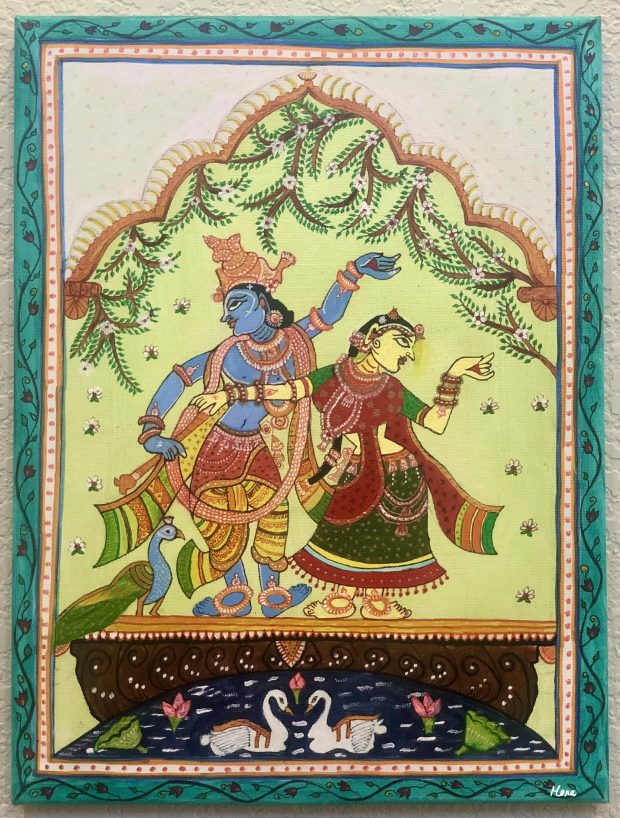Odisha is a place of rich art and culture. From ancient times various art types show the way of life of Odia people. Pattachitra is one of those types of art. This is a form of traditional art or painting makes by the Chitrakara families of Raghurajpur, Odisha based on the intricate form of Hindu mythologies. All Pattachitra paintings astonishingly illustrate traditional stories of Lord Jagannatha and Triad, Radha-Krishna (Krishna Lila), The ten incarnations of Vishnu (Dasha Avatar Patti), the stories from the Ramayana and the Mahabharata, a depiction of Lord Ganesh as a five-headed deity (Panchamukhi) and many more with a floral border. For centuries, these Pattachitra paintings are portrayed the Jagannatha culture of Odisha.
Every year in DevaSnnana Purnima, after the ceremonial bath with 108 pitchers full of water and staying longer with the wet clothes for the whole day, Lord Jagannatha and Triad, get the fever and go to the Anasara Ghara to recover in privacy under the care of Raja Vaidya. Lords are secluded inside the temporary barricade made of bamboo wood by Kotha Suara Sevakas. During Anasara time three Patta Chitra paintings of Lords are displayed for devotees in front of the bamboo barricade. This is called “Patti Dians” and they worship at “Bhitara Kathha” (Nata Mandapa) inside the main temple. The length of the each Patti Dion is 40” and the width is 30”. The Patti Dians are worshipped as Shri Basudev, represents Lord Balabhadra, Maa Bhubaneswari, represents Devi Subhadra and Shri Narayana represents Lord Jagannatha.
Patta Chitra is derived from the two Sanskrit words, “Patta” means the cloth and the ”Chitra” means the painting. The Odisha PattaChitra are classified into 3 sections depending upon the medium used for the paintings, such as “Patta Chitra”, “Bhitti
Chitra”, and “Pothi Chitra”.
Traditionally the painters are known as chitrakaras, and it is practiced by the entire family of Chitrakaras. From canvas to colors, every little thing is prepared by the Patta painters family members. “Patta Chitra”- Normally woman members of the Chitrakara family prepare a gesso from the tamarind seeds glue or the Kaitha gum and make a paste by mixing it with the chalk powder and rubbed it by taking the help of two different stones on the old cotton sarees or papers to make the Canvas in a traditional way, is called fill-in. The master artist, mostly the male member, draws the initial line and concludes with the final finishing. This gesso makes the surface of the cloth a leathery finished Canvas. On this canvas, the Patta artist paint with natural colors extracted from different vegetables, stones, and earth, etc. White color is prepared from the conch-shells by powdering, boiling, and filtering in a very tricky procedure, with lots of patience. The red color is made from ‘Hingula’, a mineral, and the yellow color is from ‘Haritala’, a stone. The blue color is extracted from ‘Ramaraja’ a sort of indigo, the black color gathered from the lamp with burning Pulanga oil or from the burning of coconut shells, and the green color derives from the neem leaves. Mostly the colors used for the Patta paintings are some limited bright colors, such as red, yellow, blue, black, green, and white. The Patta painters only use aboriginal brushes prepared by a bunch of hair of domestic animals tied to the end of a bamboo stick.
“Bhitti Chitra”- The creativity of the Patta artists is not limited to the clothes or canvases only. The deep love and passion for this art make Raghurajpur Patta Artists celebrate the art form by painting murals on the outer walls of their houses. These mural paintings are called Bitti Chitra.
“Pothi Chitra”- These are known as “Tala Pattachitra” or Palm leaf Pattachitra. After bringing Palm leaves from the tree Patta artist keep it for some time to become hard and once it is hard, these are stitched together to looks like a canvas. Then the images are traced on it and painted.
The distinctive style of Pattachitra art is carried from one generation to the next generation within a chitrakara family. This is a kind of inheritance form of art by the Patta painters of Raghurajpur. Pencil or charcoal are not used for the Patta paintings. The artists are so expert in this field that they directly draw the preliminary lines with the brush either in light red or yellow, and then they fill the colors within the lines. In the end, the glazing process starts with the final lines drawn, and the Patta is given a naturally traditional lacquer coating to protect the painting from weather and look glossy.
With the time, the way of Patta Chitra painting is also changing. It is getting more popular and commercialized. Currently, people are using different mediums to paint Pattachitras. The wall hanging, sarees, handbags, and dress materials, etc are designed with Patta arts by different Patta craftsmen and also available in the market. Instead of natural colors and traditional Patta, different types of factory-made colors are used on the modern canvases. I personally love my Odisha Pattachitra, that’s why I tried my best to put my thought in the sketch with acrylic paints. This is a form of “Krishna Lila” showing the beautiful posture of Radha-Krishna.
Article By Mona Das Adhikary, Professional Designer

